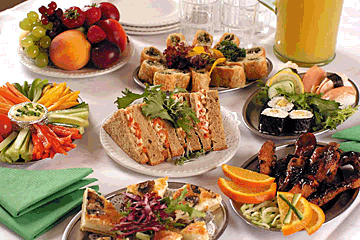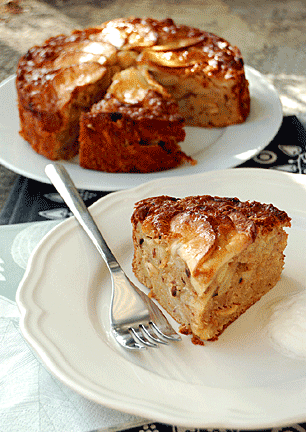Scandinavian
Hospitality:
A Hallowed Tradition
by Bob Brooke
The
Vikings were great hosts. The thread of hospitality in Scandinavia has
never been broken, and it shows no signs of fraying. The god Odin laid
down the conditions for entertaining, and his admonition to his people
rings out in a poem called "Havamal," the Viking code:
Fire he needs who
with frozen knees
Has come from the cold without
Food and clothes must the farer have
The man from the mountains come.
Water and towels and welcoming speech
Should he find who comes to the feast.
 And it was long the
custom for a Norwegian farm wife to hang under the roof of her
storehouse a basket with folded flat bread, a butter box, and cured meat
and sausage, with a white tablecloth draped over everything–just in
case someone dropped by. And it was long the
custom for a Norwegian farm wife to hang under the roof of her
storehouse a basket with folded flat bread, a butter box, and cured meat
and sausage, with a white tablecloth draped over everything–just in
case someone dropped by.
To the watery geographic
isolation of Scandinavia should be added a second formative influence–the
human isolation, until a century ago, of most Scandinavians from each
other. Distances to this day remain long in the underpopulated
countrysides of Sweden, Norway and Finland. What could they have been
like 100 years ago? The way out of a Norwegian farm was often only by
water, down long fjords and along coastal channels. In northern Sweden
even churchgoing could mean traveling miles and miles, and many of the
far-flung parishioners of the city called Lulea actually owned second
homes, cottages adjacent to their central place of worship. Thus,
instead of spending only an occasional hour or so in the presence of God
whenever weather and time permitted, they could sleep and eat in the
cottages and soak up enough religion in the church next door to last
them all through the winter, when snowed in back home.
 In addition to the
isolation of Scandinavia and the isolation of Scandinavians from each
other, something much more elemental has been at work to determine the
character of the food and cooking, and this is climate, especially
winter. Even today winter continues to be the one inescapable fact of
life in the North. The season comes early and lasts long, and, worst of
all at least from a contemporary standpoint, it’s dark–drearily so.
For centuries, people’s thinking was shaped by it, and the greater
part of their energy during the short, hectic growing season was devoted
to making sure that they would live through the winter. If many of the
foods of the area have a salty or smoky taste, or are pickled or dried,
it’s largely because of winter. The preservation of foods was the only
kind of life insurance, all important to survival. In addition to the
isolation of Scandinavia and the isolation of Scandinavians from each
other, something much more elemental has been at work to determine the
character of the food and cooking, and this is climate, especially
winter. Even today winter continues to be the one inescapable fact of
life in the North. The season comes early and lasts long, and, worst of
all at least from a contemporary standpoint, it’s dark–drearily so.
For centuries, people’s thinking was shaped by it, and the greater
part of their energy during the short, hectic growing season was devoted
to making sure that they would live through the winter. If many of the
foods of the area have a salty or smoky taste, or are pickled or dried,
it’s largely because of winter. The preservation of foods was the only
kind of life insurance, all important to survival.
As cold as it may be
during the Scandinavian winter, that’s how warm the hearts are of
Scandinavians. They readily welcome visitors into their homes to share
the bounty that they now have. The standard of living of most of
Scandinavia is one of the highest in Europe.
< Back to
A Taste of Scandinavia
Go to The Great Nordic Diet > |